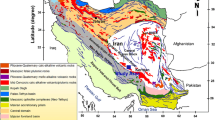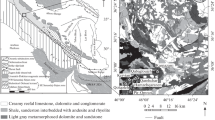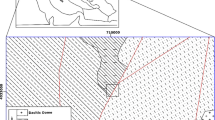Abstract
There are continuing changes in the mineral exploration methodology, specially in the processing, analysis, and interpretation of geological exploration data. Many new data integration techniques based on GISs allow multiple sets of exploration survey data to be processed and fused quickly and precisely, so that the assessment on the final target(s) deposit can be more accurate than conventional approaches.
Raw exploration data gathered in field, or old archived exploration data in local government mining offices, are usually in differing data formats, which usually require editing and preprocessing of the data prior to an information representation step utilizing a chosen mathematical tool. In this study, we collected several sets of old geological exploration data, digitized, processed and geocoded each layer of spatial data, and then digitally represented using fuzzy logic for later fusion. In the Seobyeog-ri (Korea) study area, there was also and old tungsten mine, which we used as a ground-truthing control point. The target proposition adopted is that “there is a tungsten (W) and molibdenum (Mo) mineralization” in the study area and the mineral deposit model used was a simple skarn type contact mineralization.
Although several authors have recently used fuzzy logie approaches for fusion of mineral exploration data, selecting an optimum fuzzy operator has always been a difficult task. It has become apparent that fuzzy operators depend very much on the deposit model and types of spatial data to be integrated. In this study, three types of operators, fuzzy OR, fuzzy AND, and fuzzy γ-operators are tested and selected ones are used in combination, some in series and others in parallel. The unbiased processing results obtained in this study indicate that the most probable target area is clearly outlined in the vicinity of the old Sangdong tungsten (W) mine, and have confirmed our initial proposition. However, the initial assumption of a skarn type mineralization could not be further verified requiring further investigation.
Similar content being viewed by others
References
An, P., 1992, Spatial Reasoning and Integration Techniques for Geophhsical and Geological Exploration Data. Unpublished Ph.D. thesis, University of Manitoba, Winnipeg, Canada.
An, P., Moon, W.M. and Rencz, A., 1991, Application of fuzzy set theory to integrated mineral exploration. Canadian Journal of Exploration Geophysics, 27, 1–11.
An, P., Moon, W.M. and Bonham-Carter, G.F., 1994, Uncertainty management in integration of exploration data using the belief function. Non-Renewable Resources, 3, 60–71.
Bonham-Carter, G.F., 1994. Geographic Information Systems for Geoscientists: Modeling with GIS. Pergamon Press, New York, 398 p.
Bonham-Carter, G.F., Agterberg, F.P. and Wright, D.F., 1989, Weights of evidence modelling: a new approach to mapping mineral potential. In: Agterber, F.P. and Bonham-Carter, G.F. (eds.), Statistical Applications in the Earth Sciences. Geological Survey of Canada, Paper 89–9, p. 171–183.
Dawson, K.M., 1996, Skarn Tungsten. In: Eckstrand, O.R., Sinclair, W.D. and Thorpe, R.I. (eds.), Geology of Canadian Mineral Deposit Types. Geological Survey of Canada, 8, 495–502.
Farrar, E., Clark, A. and Kim, O.J., 1978. Scientific communications: age of the Sandong tungsten deposit, Republic of Korea, and its bearing on the metallogeny of the southern Korean peninsula. Economic Geology, 73, 547–566.
Geological Society of Korea, 1961, Geological map sheet of Seobyeogri, #15. Geological Society of Korea.
GRASS 4.1 Reference Manual, 1993, U.S. Army Corps of Engineers, Construction Engineering Research Laboratories, Champaign, Illinois, p. 422–425.
John, Y.W., 1963. Geology and origin of Sandong tungsten mine, Republic of Korea. Economic Geology, 58, 1285–1300.
Klepper, M.R., 1947. The Sandong tungsten deposit, southern Korea. Economic Geology, 42, 465–477.
Lee, D.W. and Kim, S.W., 1965, Geological map of Seobyeog-ri sheet. Korea Institute of Geology, Mining & Materials.
Lee, J.S., Yun, H.S., Jin, M.S., Kim, S.J. and Lee, C.Y., 1983. Geochemical Maps for Seobyeog Sheet in the Taebaegsan Mineralized Belt. Korea Institute of Energy and Resources.
Meinert, L.D., 1992. Skarns and skarn deposits. Geoscience Canada, 19, 145–162.
Mitasova, H. and Mitas, L., 1993a, Interpolation by regularized spline with tension: I. theory and implementation. Mathematical Geology, 25, 641–655.
Mitasova, H. and Mitas, L., 1993b, Interpolation by regularized spline with tension: II. application to terrain modeling and surface geometry analysis. Mathematical Geology, 25, 657–669.
Moon, W.M., 1990. Integration of geophysical and geological data using evidential belief function. IEEE Transactions on Geoscience and Remote Sensing, 28, 711–720.
Moon, W.M., 1993. On mathematical representation and integration of multiple spatial geoscience data sets. Canadian Journal of Remote Sensing, 19, 63–67.
Moon, W.M., Jiang, W.W., So, C.S. and Yoon, S.T., 1998, Application of spatial data integration technique and utilization of SIRD Data for geological investigation (Hwanggang-ri, Korea). (In preparation)
Park, Y.S., Koo, J.H., Suh, S.Y. and Choi, J.H., 1988, Aerial gamma ray and magnetic survey map. Korea institute of Energy and Resources.
Zadeh, L.A., 1965. Fuzzy sets. Information and Control, 8, 338–353.
Zadeh, L.A., 1978. Fuzzy sets as a basis for a theory of possibility. Fuzzy Sets and Systems, 1, 3–28.
Zimmermann, H. and Zysno, J.P., 1980. Latent connectives, human decision making. Fuzzy Sets and Systems, 4, 37–51.
Author information
Authors and Affiliations
Corresponding author
Rights and permissions
About this article
Cite this article
Choi, S., Moon, W.M. & Choi, SG. Fuzzy logic fusion of W-Mo exploration data from Seobyeog-ri, Korea. Geosci J 4, 43–52 (2000). https://doi.org/10.1007/BF02910126
Received:
Accepted:
Issue Date:
DOI: https://doi.org/10.1007/BF02910126




